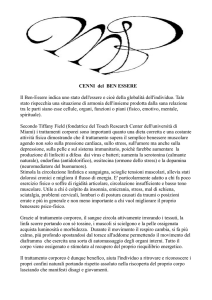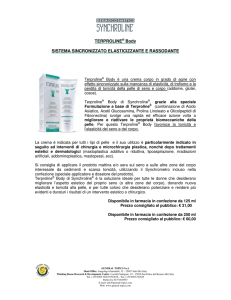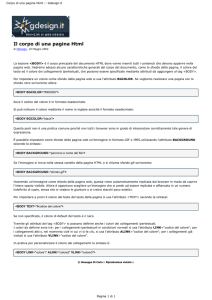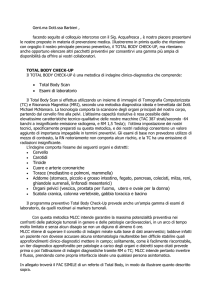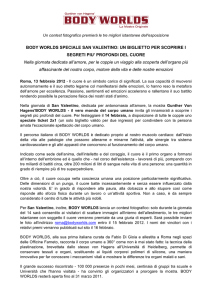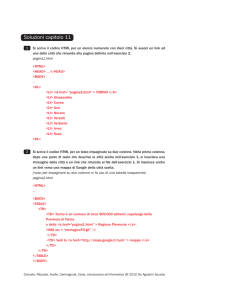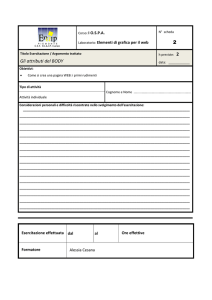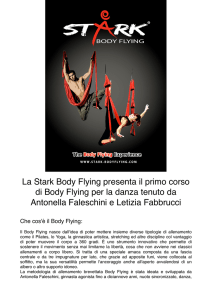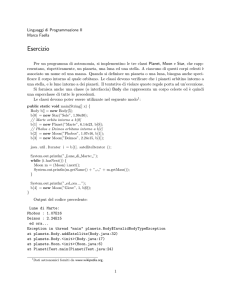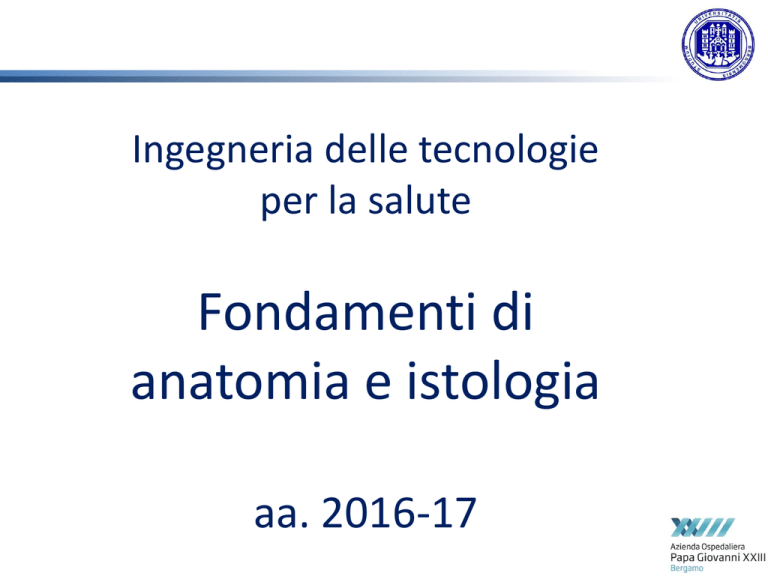
Ingegneria delle tecnologie
per la salute
Fondamenti di
anatomia e istologia
aa. 2016-17
LEZIONE 1
Presentazione del corso
Generalità
Organizzazione strutturale del corpo umano
Terminologia
DOCENTI
Dott. Luca Ansaloni
Dott. Federico Coccolini
Dott. Marco Ceresoli
[email protected]
[email protected]
[email protected]
METODI DIDATTICI
Lezione frontali, laboratorio
su manichino digitale
Tot 64 ore (I semestre)
TESTI DI RIFERIMENTO
- OpenStax Anatomy and physiology
(https://openstax.org/details/anatomy-and-physiology)
- Eroschenko V. "diFiore’s atlas of histology with
functional correlations" 12th ed. 2013 Lippincott
Williams & Wilkins, Philadelphia, USA
- Feneis H. and Dauber W. "Pocket Atlas of Human
Anatomy" 4th ed. Thieme New York, New York, USA
- Snell R.S. "Clinical anatomy by regions" 9th ed.
2012 Lippincott Williams & Wilkins, Philadelphia, USA
- Kamina P. "Atlante di Anatomia" 2014 Piccin,
Padova, Italy
- "The Biodigital Human" https://www.biodigital.com/
PROGRAMMA
Il corso ha come principali finalità la conoscenza dell’organizzazione micro e
macroscopica del corpo umano al fine di rendere possibile la comprensione della
fisiologia e della patogenesi delle malattie.
In particolare gli argomenti trattati dal corso saranno i seguenti: anatomia generale;
cenni di citologia; istologia; cenni di embriologia generale; anatomia macroscopica e
microscopica degli organi dell’apparato locomotore, dell’apparato circolatorio,
dell’apparato respiratorio, dell’apparato digerente, dell’apparato
urinario, dell’apparato genitale femminile, dell’apparato genitale maschile,
dell’apparato endocrino, dell’apparato tegumentario; organizzazione anatomica del
sistema nervoso centrale e del sistema nervoso periferico; apparati della sensibilità
specifica; cenni di anatomia topografica, radiologica e clinica.
PROGRAMMA
ANATOMIA GEN. Organizzazione del corpo umano: cellule, tessuti, organi, apparati.
Terminologia anatomica, piani di riferimento, terminologia relativa ai movimenti. Spazi
corporei.
CITOLOGIA Cell. eucariote. Membrana cell. Citosol, organelli citoplasmatici e nucleo.
ISTOLOGIA Classificazione dei tessuti. Epiteli: di rivestimento; secernenti (esocrini,
endocrini); sensoriali. Endoteli. T. connettivo: propriamente detto; t. adiposo; t. cartilagineo;
t. osseo. Sangue: plasma ed elementi corpuscolati. T. muscolare (liscio; striato scheletrico e
cardiaco). T. nervoso: neuroni, dendriti, assoni, fibre mieliniche. Cellule gliali. Mielina.
Sinapsi.
APPARATO LOCOMOTORE A. macro-microscop. di ossa, muscoli, tendini. Architettura gen.
(segmenti scheletrici, articolazioni, gruppi muscolari) di testa, colonna vertebrale, cingolo
scapolare, arto sup., torace, parete add., cingolo pelvico e arto inf.
APPARATO CIRCOLATORIO Struttura dei vasi (arterie, vene, capillari, vasi linfatici). Cuore e
pericardio. Tessuto di conduzione cardiaco. Arterie della circolazione gen.: origine, decorso e
territorio di vascolarizzazione. Vene della circolazione gen.: origine, decorso e territorio di
drenaggio. Sistema linfatico: dotti linfatici, drenaggio linfatico e stazioni linfonodali dei
distretti corporei. A. macro-microscop. di timo, milza, linfonodi, tonsille, tessuto linfoide
associato alle mucose. Midollo osseo.
PROGRAMMA
APPARATO RESPIRATORIO Organizzazione gen. dell’apparato respiratorio. A. macro-microscop. di naso, cavità nasali e
paranasali, laringe, trachea, albero bronchiale, polmone e pleure. Vascolarizzazione funzionale e nutrizia del polmone.
Mediastino.
APPARATO DIGERENTE A. macro-microscop. di cavità buccale, ghiandole salivari, faringe, esofago, stomaco, intestino
tenue (duodeno, digiuno, ileo), intestino crasso (ceco, appendice vermiforme, colon, retto), fegato, vie biliari
extraepatiche e pancreas. Cavità peritoneale. Organizzazione gen. della circolazione splancnica; vena porta.
APPARATO URINARIO A. macro-microscop. di reni, ureteri, vescica, uretra.
APPARATO GENITALE FEMMINILE E MASCHILE A. macro-microscop. di ovaio, utero, tube uterine, vagina, genitali
esterni f., testicolo, dotto deferente, vescicole seminali, prostata e genitali esterni m. Pelvi e perineo.
APPARATO ENDOCRINO A. macro-microscop. di ipofisi, epifisi, tiroide, paratiroidi, surrene, pancreas endocrino e
sistema endocrino diffuso.
APPARATO TEGUMENTARIO A. macro-microscop. di cute, annessi cutanei e mammella.
SISTEMA NERVOSO CENTRALE E PERIFERICO A. macro-microscop. di midollo spinale, tronco encefalico, cervelletto,
lamina quadrigemina, diencefalo, telencefalo. Ventricoli cerebrali e circolazione liquorale. Meningi. Vascolarizzazione
del SNC. Vie della sensibilità generale. Retina e vie ottiche, recettori e vie statoacustiche, via gustativa, via olfattiva. Vie
discendenti di moto. Sistemi di controllo del movimento: gangli della base, cervelletto. Sistemi di regolazione delle
funzioni viscerali e attività emozionali : recettori e vie della sensibilità viscerale; ipotalamo; sistema limbico. Sistemi di
regolazione delle funzioni cognitive e comportamentali. Formazione reticolare del tronco encefalico. Struttura dei
nervi periferici e gangli. Sistema nervoso vegetativo: ortosimpatico, parasimpatico. Nervi spinali, plessi dei nervi
spinali, nervi encefalici.
APPARATI DELLA SENSIBILITÀ SPECIFICA A. macroscopica e microscopica del bulbo oculare e dell’orecchio (est, medio,
int).
ESAMI
Introduzione del corso. introduzione
all’anatomia: terminologia. Organizzazione
generale: cellule tessuti organi apparati
sistemi.
Overview of Anatomy and Physiology
By the end of this section, you will be able to:
• Compare and contrast anatomy and physiology, including their specializations
and methods of study
• Discuss the fundamental relationship between anatomy and physiology
Human anatomy is the scientific study of the body’s structures.
The word “anatomy”
comes from a Greek
root that means “to
cut apart.”
Lezione di anatomia del
dottor Tulp, Rembrandt
(1632)
Overview of Anatomy and Physiology
areas of specialization:
Gross anatomy is the study of the larger structures of the body, those visible
without the aid of magnification, also referred to as macroscopic anatomy.
Microscopic anatomy is the study of structures that can be observed only
with the use of a microscope or other magnification devices, includes cytology, the
study of cells and histology, the study of tissues.
Overview of Anatomy and Physiology
2 general approaches to the study of the body’s structures:
regional anatomy is the study of the interrelationships of all
of the structures in a specific body region
systemic anatomy is the study of the structures that make up
a discrete body system—that is, a group of structures that
work together to perform a unique body function.
Overview of Anatomy and Physiology
Whereas ANATOMY is about structure, PHYSIOLOGY is about
function.
Human physiology is the scientific study of the chemistry and
physics of the structures of the body and the ways in which
they work together to support the functions of life. Much of
the study of physiology centers on the body’s tendency toward
homeostasis.
HOMEOSTASIS = state of steady internal conditions
maintained by living things.
Form is closely related to function in all living things.
Your study of anatomy and physiology will make more sense if
you continually relate the form of the structures you are
studying to their function. In fact, it can be somewhat
frustrating to attempt to study anatomy without an
understanding of the physiology that a body structure supports.
Structural Organization of the Human Body
By the end of this section, you will be able to:
• Describe the structure of the human body in terms of six levels of organization
• List the eleven organ systems of the human body and identify at least one organ
and one major function of each
Basic architecture of the human body:
its smallest parts are assembled into larger structures
the structures of the body to be considered in terms of
fundamental levels of organization that increase in
complexity
Structural Organization of the Human Body
subatomic particles, atoms,
molecules, organelles,
cells,
tissues,
organs,
organ systems,
organisms and biosphere
Structural Organization of the Human Body
Assigning organs to
organ systems can be
imprecise since organs
that “belong” to one
system can also have
functions integral to
another system.
11 distinct organ systems in the human body
Functions of Human Life
By the end of this section, you will be able to:
• Explain the importance of organization to the function of the human organism
• Distinguish between metabolism, anabolism, and catabolism
• Provide at least two examples of human responsiveness and human movement
• Compare and contrast growth, differentiation, and reproduction
• different organ systems have different functions and
therefore unique roles to perform in physiology
• functions can be summarized in terms of a few that
we might consider definitive of human life:
organization, metabolism, responsiveness,
movement, development, and reproduction
Functions of Human Life
Organization
A human body consists of trillions of cells organized in a way that maintains distinct internal compartments.
These compartments keep body cells separated from external environmental threats and keep the cells moist
and nourished. They also separate internal body fluids from the countless microorganisms that grow on body
surfaces, including the lining of certain tracts, or passageways.
Metabolism
The first law of thermodynamics holds that energy can
neither be created nor destroyed—it can only change form.
Your basic function as an organism is to consume (ingest)
energy and molecules in the foods you eat, convert some
of it into fuel for movement, sustain your body functions,
and build and maintain your body structures. There are
two types of reactions that accomplish this:
Anabolism is the process whereby smaller, simpler
molecules are combined into larger, more complex
substances.
Catabolism is the process by which larger more
complex substances are broken down into smaller simpler
molecules.
Metabolism is the sum of all anabolic and catabolic
reactions
that take place in the body and occur
simultaneously and continuously.
adenosine triphosphate (ATP)
Functions of Human Life
Responsiveness
the ability of an organism to adjust to changes in its internal and external environments.
Movement
Human movement includes not only actions at the joints of the body, but also the
motion of individual organs and even individual cells.
Development, growth and reproduction
Development = all of the changes the body goes through in life, including the
processes of differentiation, growth, and renewal.
Growth = the increase in body size, by increasing the number of existing cells,
increasing the amount of non-cellular material around cells (such as mineral deposits
in bone), and, within very narrow limits, increasing the size of existing cells.
Reproduction = the formation of a new organism from parent organisms.
Requirements for Human Life
By the end of this section, you will be able to:
• Discuss the role of oxygen and nutrients in maintaining human survival
• Explain why extreme heat and extreme cold threaten human survival
• Explain how the pressure exerted by gases and fluids influences human survival
H. Sapiens has been adapted to life on Earth for at least the past 200,000 years with 4
requirements of life.
Oxygen
Atmospheric air is only about 20% oxygen, but that oxygen is a key component of the chemical
reactions that keep the body alive, including the reactions that produce ATP, important
especially for brain.
Nutrients
= substance in foods and beverages that is essential to human survival. 3 basic classes of
nutrients are water, the energy-yielding and body-building nutrients, and the micronutrients
(vitamins and minerals). Water and the energy-yielding nutrients also referred to as
macronutrients because the body needs them in large amounts. Some others micronutrients,
such as vitamin C and most of the B vitamins, are water-soluble and cannot be stored, so you
need to consume them every day or two.
Requirements for Human Life
Narrow Range of Temperature
T may cause deaths because chemical reactions upon which the body depends can only
take place within a narrow range of body T, from just below to just above 37°C (98.6°F).
When body temperature rises well above or drops well below normal, enzymes that
facilitate chemical reactions lose their normal structure and their ability to function and
the chemical reactions of metabolism cannot proceed.
Body can respond effectively to short-term exposure to heat (sweating) or cold (shivering
and increased breakdown of stored energy to generate heat. (When that energy reserve
is depleted, however, and the core temperature begins to drop significantly, red blood
cells will lose their ability to give up oxygen, denying the brain of this critical component
of ATP production).
Requirements for Human Life
Narrow Range of Atmospheric Pressure
Pressure is a force exerted by a substance that is in contact with another substance.
Atmospheric pressure is pressure exerted by the mixture of gases (primarily nitrogen
and oxygen) in the Earth’s atmosphere. Although you may not perceive it, atmospheric
pressure is constantly pressing down on your body. This pressure keeps gases within
your body, such as the gaseous nitrogen in body fluids, dissolved. Atmospheric pressure
does more than just keep blood gases dissolved. Your ability to breathe—that is, to take
in oxygen and release carbon dioxide—also depends upon a precise atmospheric
pressure.
Homeostasis
By the end of this section, you will be able to:
• Discuss the role of homeostasis in healthy functioning
• Contrast negative and positive feedback, giving one physiologic example of
each mechanism
Set point = the physiological value
around which the normal range
fluctuates.
Normal range = the restricted set of
values that is optimally healthful and
stable.
Control centers in the brain and other
parts of the body monitor and react to
deviations from homeostasis using
negative feedback.
Negative feedback = a mechanism that
reverses a deviation from the set point,
maintaining body parameters within
their normal range, it has 3 basic
components: sensor, (receptor), control
center, effector.
Homeostasis
Positive Feedback
Positive feedback intensifies a change
in the body’s physiological condition
rather than reversing it. A deviation
from the normal range results in more
change, and the system moves
farther away from the normal range.
Positive feedback in the body is
normal only when there is a definite
end point. Childbirth and the body’s
response to blood loss are two
examples of positive feedback loops
that are normal but are activated only
when needed.
Anatomical Terminology
By the end of this section, you will be able to:
• Demonstrate the anatomical position
• Describe the human body using directional and regional terms
• Identify three planes most commonly used in the study of anatomy
• Distinguish between the posterior (dorsal) and the anterior (ventral) body cavities,
identifying their subdivisions and representative organs found in each
• Describe serous membrane and explain its function
the purpose of this language is not to confuse, but rather to
increase precision and reduce medical errors: by using
precise anatomical terminology, we eliminate ambiguity.
Anatomical Terminology
Anatomical Position
To further increase precision, anatomists
standardize the way in which they view the
body: the standard body “map,” or anatomical
position, is that of the body standing upright. It
does not matter how the body being described
is oriented, the terms are used as if it is in
anatomical position.
A body lying down is described as either prone
(= face-down orientation) or supine(= face up
orientation).
Anatomical Terminology
Regional
Terms
The human body’s
numerous regions have
specific terms to help
increase precision
Anatomical Terminology
Directional
Terms
directional anatomical terms
appear throughout anatomy
textbook and are essential for
describing the relative
locations of different body
structures.
Anatomical Terminology
Body Planes
Section
= 2-dimensional surface of a 3-dimensional
structure that has been cut [scan (“virtual sections”) of living
bodies for modern medical imaging]
Body sections and scans can be correctly interpreted, however, only if the
viewer understands the plane along which the section was made.
Plane
= imaginary 2-dimensional surface that passes
through the body.
Anatomical Terminology
Body Planes
3 planes commonly referred to in
anatomy:
• sagittal = divides vertically into
right and left sides: if runs directly
down the middle of the body, it is
called the midsagittal or median
plane (if divides into unequal right and
left sides, it is called parasagittal or
longitudinal plane).
• frontal = divides into an anterior
(front) portion and a posterior (rear)
portion (often referred to as a
coronal plane).
• transverse = divides the body or
organ horizontally into upper and
lower portions (cross sections).
Anatomical Terminology
Body Cavities and Serous Membranes
The body maintains its internal organization by means of membranes, sheaths, and
other structures that separate compartments. The dorsal (posterior) cavity and the
ventral (anterior) cavity are the largest body compartments.
Anatomical Terminology
Abdominal Regions and Quadrants
To promote clear communication, for instance about the location of a patient’s
abdominal pain or a suspicious mass, health care providers typically divide up the
cavity into either 9 regions or 4 quadrants
Anatomical Terminology
Membranes of the Anterior (Ventral) Body Cavity
A serous membrane (also referred to a serosa) is one of the thin membranes that
cover the walls and organs in the thoracic and abdominopelvic cavities. The parietal
layers of the membranes line the walls of the body cavity. The visceral layer of the
membrane covers the organs (the viscera). Between the parietal and visceral
layers is a very thin, fluid-filled serous space, or cavity.
3 serous cavities
and their associated
membranes:
1. pleura
2. pericardium
3. peritoneum
Medical Imaging
By the end of this section, you will be able to:
• Discuss the uses and drawbacks of X-ray imaging
• Identify four modern medical imaging techniques and how they are used
fourteenth and fifteenth centuries: Leonardo da Vinci and Andreas Vesalius
late nineteenth century: non-surgical methods to look inside the living body
Perfezione del corpo umano?
La natura possiede delle perfezioni per
mostrare che essa è l’immagine di Dio; e
dei difetti, per mostrare che ne è solo
l’immagine.
(Blaise Pascal)
GENESI cap 1
26 Poi Dio disse: «Facciamo
l'uomo a nostra immagine,
conforme alla nostra somiglianza,
e abbiano dominio sui pesci del
mare, sugli uccelli del cielo, sul
bestiame, su tutta la terra e su
tutti i rettili che strisciano sulla
terra». 27 Dio creò l'uomo a sua
immagine; lo creò a immagine di
Dio; li creò maschio e femmina.
…31 Dio vide tutto quello che
aveva fatto, ed ecco, era molto
buono. Fu sera, poi fu mattina:
sesto giorno.
…errori di design…
«è chiaro che non era Sua intenzione
farci camminare su due gambe, ma
abbiamo perversamente insistito per
farlo e il risultato sono i problemi che
oggi affliggono la nostra spina dorsale e
le nostre ginocchia. Sarebbe auspicabile
se, per cancellare questo errore, Lei
potesse raddrizzare il bacino al giusto
angolo retto o rafforzare le giunture
delle ginocchia che reggono tutto il peso
corporeo»
Brown P. «Letter to God» BMJ 2006;332:1341
doi: http://dx.doi.org/10.1136/bmj.332.7553.
1341
…errori di design…
eliminare le tonsille, che notoriamente non servono a niente, e
riempire le cavità nasali, che vuote come sono diventano un comoda coltura per l
e infezioni;
rimpicciolire le falangette, ossia la punta delle dita delle mani, per facilitare la
scrittura sulla tastiera del
computer, del Blackberry e del telefonino (ma polpastrelli più piccoli significa a
nche impronte digitali più
piccole, complicando le indagini della polizia); aggiungere un fegato e un cuore di
riserva, per poter
bere alcolici e mangiare una cucina grassa quanto si vuole, senza preoccupazioni
dietetiche e per la
salute; eliminare l'appendice, di cui ci accorgiamo solo quando si infetta e bisog
na dunque toglierla;
ricollocare i genitali maschili in una zona del corpo meno vicina agli organi dell'e
screzione e
possibilmente più riparata, al sicuro da colpi e oggetti volanti, per esempio mett
endoli sotto le ascelle e rendendoli estraibili.
Brown P. «Letter to God» BMJ 2006;332:1341
doi: http://dx.doi.org/10.1136/bmj.332.7553.
1341
[email protected]
[email protected]

